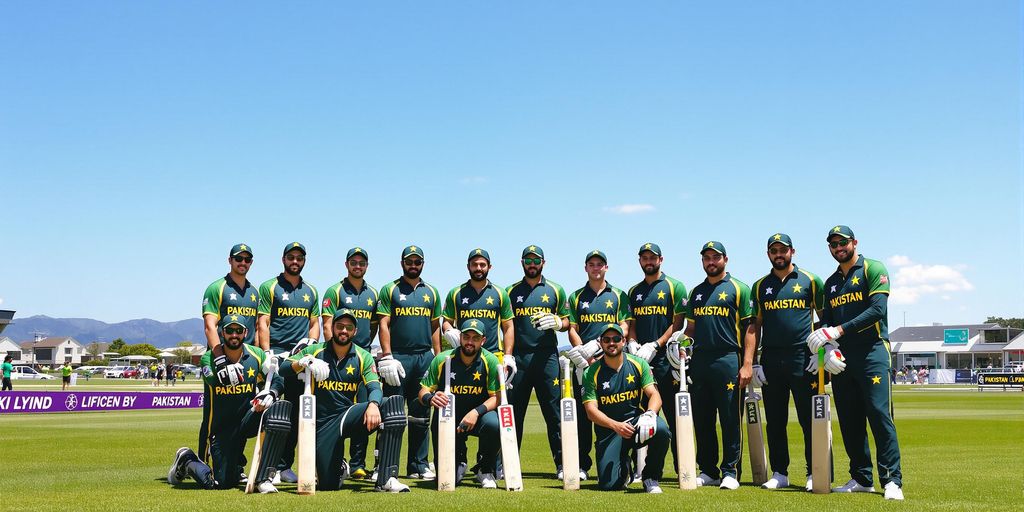Leadership Dynamics Within The Pakistan T20 Squad
Shaheen Afridi’s Captaincy Role
Shaheen Afridi’s appointment as T20 captain marks a new chapter for Pakistan cricket. His aggressive bowling style and on-field presence are expected to translate into proactive leadership. He’s got a tough job ahead, but the board seems to think he’s up to it. It’ll be interesting to see how he handles the pressure of leading the side, especially against a tough opponent like New Zealand. His leadership qualities will be tested.
Transition From Babar Azam
The transition from Babar Azam’s captaincy is a significant moment. Babar led the team for a fair while, and there’s bound to be some adjustment as Shaheen takes over. It’s all about keeping the team united and focused during this change. The team needs to move forward. Some fans are sad to see Babar go, but most are excited for the future.
Impact of Leadership Changes
Leadership changes can really shake things up, and it’s not always smooth sailing. Here’s what we might see:
- New strategies and tactics on the field.
- Changes in team dynamics and player roles.
- A different approach to handling pressure situations.
It’s crucial for the team to adapt quickly to Shaheen’s leadership style. The success of this transition will depend on how well the players rally behind their new captain and embrace the changes he brings. A united front is essential for a strong performance in the upcoming tour. The T20 squad needs to work together.
Emerging Talents In The Squad
Profiles of Young Players
Pakistan’s T20 squad for the New Zealand tour in 2025 features some exciting young players eager to make their mark. Saim Ayub is one to watch; an aggressive left-handed batter known for his fearless approach. Then there’s Abbas Afridi, a promising fast bowler with the ability to generate good pace and movement. Haseebullah Khan, a wicketkeeper-batsman, adds depth to both departments. These players represent the future of Pakistan cricket, and this tour provides a golden opportunity to showcase their skills on the international stage.
Potential Impact on Team Performance
These emerging talents bring a fresh dynamic to the team. Saim Ayub’s aggressive batting style can provide quick starts, while Abbas Afridi’s pace can trouble opposition batsmen. Haseebullah Khan offers flexibility in the batting order and reliable wicketkeeping. Their inclusion aims to inject energy and unpredictability into Pakistan’s T20 setup.
Future Prospects for Emerging Stars
The New Zealand tour is a crucial stepping stone for these young players. Strong performances could cement their places in the national side for future tournaments, including the next T20 World Cup. The PCB is investing in youth development, and these players are the embodiment of that vision. Their progress will be closely monitored, and their success is vital for the long-term health of Pakistan T20 cricket. Wahab Riaz mentioned the team’s strategy to see which players fit into positions 4-7, so this is a great opportunity for them.
This tour is more than just a series; it’s an audition for the future stars of Pakistan cricket. The experience gained in New Zealand will be invaluable as they develop into seasoned professionals. The focus is on building a strong core of players who can consistently perform at the highest level.
Here’s a look at their potential roles:
- Saim Ayub: Opening batsman, powerplay aggressor
- Abbas Afridi: Fast bowler, death overs specialist
- Haseebullah Khan: Middle-order batsman, backup wicketkeeper
Key Players To Watch
Babar Azam’s Batting Prowess
Babar Azam is always one to watch. His consistency at the top of the order is vital for Pakistan. He’s got a knack for building innings and putting pressure on the opposition. It’s not just about scoring runs; it’s about setting the tone for the whole batting lineup. If he gets going, the team usually does too.
Mohammad Rizwan’s Wicketkeeping Skills
Rizwan is a busy player. He’s always involved, whether it’s with the bat or behind the stumps. His glove work is top-notch, and he’s got a safe pair of hands. He’s also become a really handy batter, capable of accelerating the scoring rate when needed. He’s a real asset to the team.
Fakhar Zaman’s Explosive Batting
Fakhar Zaman is the kind of player who can change a game in a few overs. When he’s on song, he’s almost impossible to stop. He’s got the power to clear the boundary with ease, and he’s not afraid to take risks. He can be a bit inconsistent, but when he clicks, he’s a match-winner. He’s the kind of player that fans love to watch.
Fakhar’s role is pretty simple: go out there and smash it. The team needs him to provide that explosive start, especially in those crucial T20 matches. If he can get the team off to a flyer, it takes a lot of pressure off the other batters.
Bowling Attack Analysis

Shaheen Afridi’s Bowling Strategy
Shaheen Afridi is the spearhead, no doubt. His ability to swing the new ball at pace is world-class. We’re expecting him to target the top order early, trying to get those crucial breakthroughs. It’ll be interesting to see how he uses his variations later in the innings, especially his slower balls and yorkers. He’s also got the added pressure of captaincy, so how he manages his own bowling workload will be key. His leadership role is important for the team.
Haris Rauf’s Pace and Variations
Haris Rauf brings raw pace, something every team craves. His express speed can unsettle any batter, but he needs to be consistent with his line and length. He’s been working on his slower balls and knuckleballs, which could be handy on the New Zealand pitches. If he can control his variations, he’ll be a real handful.
Role of Spin Bowlers in the Squad
The spin department will be interesting. With Usama Mir and Abrar Ahmed in the squad, Pakistan has some options.
Here’s what they bring to the table:
- Usama Mir: Leg-spin, can be attacking.
- Abrar Ahmed: Mystery spin, difficult to pick.
- Mohammad Nawaz: Left-arm orthodox, economical.
The pitches in New Zealand might not offer as much turn as in the subcontinent, so the spinners will need to be smart with their variations and bowl tight lines. Their ability to control the middle overs and pick up key wickets will be vital for Pakistan’s success. They need to use the conditions to their advantage.
Wicketkeeping Options
Comparison of Azam Khan and Mohammad Rizwan
Okay, so we’ve got a bit of a wicketkeeping conundrum, haven’t we? Mohammad Rizwan is the established player, no doubt. He’s been rock solid behind the stumps and a consistent run-scorer. But then there’s Azam Khan. He’s got that raw power, that ability to just clear the ropes. It’s a classic case of experience versus explosive potential.
Impact of Haseebullah Khan
Haseebullah Khan is the young gun in the mix. He’s been making waves in domestic cricket, and the selectors clearly see something in him. Whether he gets a proper run in this series remains to be seen, but his inclusion signals a focus on building for the future. He could be a real surprise package, offering a different dimension to our batting lineup.
Wicketkeeping Strategies for T20
Wicketkeeping in T20 is more than just catching balls, right? It’s about:
- Quick reflexes
- Stumping opportunities
- Reading the batsman
- Contributing with the bat
The strategy will likely depend on the match situation. If we need stability, Rizwan is the obvious choice. If we’re chasing a big total and need someone to go ballistic, Azam Khan might get the nod. Haseebullah is probably there to learn and provide backup, but don’t rule out a surprise appearance if the opportunity arises.
Ultimately, the best approach might be to rotate the keepers, giving each a chance to prove themselves in different conditions. It’ll be interesting to see how Shaheen Afridi manages this aspect of the team.
Squad Selection Insights

Criteria for Player Selection
So, how do they actually pick the blokes for the squad? It’s not just about who’s smashing sixes or taking wickets, though that obviously helps. The selectors look at a bunch of things. Form in domestic cricket is massive – you can’t ignore someone who’s consistently performing well in the local comps. They also consider experience, especially for big tours like this one to New Zealand. Then there’s the whole team balance thing; you need a mix of power hitters, steady batsmen, pace bowlers, and spinners to cover all bases.
- Recent domestic performance
- International experience
- Team balance and player roles
Exclusions and Their Implications
Right, so who missed out and why? That’s always a hot topic. Sometimes it’s down to form – a player might just be going through a rough patch. Other times, it could be tactical; the selectors might want to try out some new faces or go with a different strategy. The exclusion of certain players can have a big impact on the team’s dynamics. It can open up opportunities for younger players to step up, but it can also leave gaps in experience and leadership. It’s a tough call, and the selectors cop a fair bit of flak no matter what they do. A former batter made a controversial statement about a player’s selection.
It’s always a gamble leaving out established players. You’re hoping the new guys can fill their boots, but there’s no guarantee. It can either inject fresh energy into the team or leave them looking a bit lost.
Focus on Domestic Performers
There’s been a real push lately to give more opportunities to blokes who are tearing it up in domestic cricket. The idea is that if someone’s consistently performing well at that level, they deserve a shot at the big time. It’s a good way to build depth in the squad and give young players a taste of international cricket. Plus, it sends a message to all the players out there that if you put in the hard yards and perform, you’ll get noticed. Domestic cricket is the breeding ground for future stars, after all.
| Player | Role | Domestic Performance Highlights |
|---|---|---|
| Sahibzada Farhan | Batsman | Scored heavily in the National T20 Cup |
| Abbas Afridi | Bowler | Consistently took wickets in the domestic circuit |
| Haseebullah Khan | Wicketkeeper | Showcased great form in the domestic first class cricket |
Tactical Approaches for New Zealand Tour
Adapting to New Zealand Conditions
Okay, so New Zealand. Think green pitches and potentially a bit of swing. Our batters are going to need to be patient early on, playing the ball late. Adaptability is key. We can’t just go in there expecting to blast every ball to the boundary. The bowlers need to hit the right lengths, too. Short stuff might get punished, so it’s about finding that nagging line and length that makes the batsmen play.
Game Plans Against Key Opponents
Against New Zealand, we need to target their key players early. Get Williamson out cheaply, and you put a lot of pressure on the rest of their batting lineup. With the ball, we need to be smart. Can’t just bowl the same stuff to everyone. Different batsmen have different weaknesses, and we need to exploit them. Here’s a quick look at potential match-ups:
- Shaheen Afridi vs. Kane Williamson: Early swing crucial.
- Haris Rauf vs. Finn Allen: Use pace to unsettle.
- Spinners vs. Phillips/Neesham: Control the middle overs.
Utilising Home Advantage
Okay, so New Zealand is their home advantage, not ours. But we can still use what we know. We’ve played against these guys before, we know their strengths and weaknesses. It’s about doing our homework, watching the footage, and coming up with a plan that works. We need to be smart about our field placements, our bowling changes, and our batting strategies. It’s not about reinventing the wheel, it’s about executing the basics well.
Look, touring New Zealand is never easy. The conditions are different, the crowds are hostile, and the opposition is always tough. But if we go in there with a clear plan, a positive attitude, and a willingness to fight for every run and every wicket, we’ve got a chance. It’s all about believing in ourselves and backing our ability.
Historical Context of Pakistan T20 Performance
Past Tours to New Zealand
Pakistan’s T20 record in New Zealand is a bit of a mixed bag. They’ve had some cracking wins, but also some pretty ordinary performances. It’s fair to say that adapting to the conditions has often been a challenge. The pitches can be quite different to what they’re used to back home, and the weather can play a big part too. This upcoming tour will be a good test of how far they’ve come in handling those challenges. They’ll need to bring their A-game to secure a series win.
T20 World Cup Performances
Pakistan has had some memorable moments in T20 World Cups. They were crowned champions in 2009, which was an amazing achievement. However, they’ve also had their fair share of disappointments. Consistency has been the key issue, with the team sometimes struggling to maintain their form throughout the tournament. The pressure of a World Cup can really get to some players, and it’s important to have a squad that can handle that pressure. Looking back at their T20 series results, it’s clear that building a team for the long haul is essential.
Lessons Learned from Previous Series
Each series, win or lose, provides valuable lessons. One thing that’s become clear is the importance of having a flexible game plan. What works in one series might not work in another, so it’s important to be able to adapt. Also, the team needs to be better at closing out games. Too often, they’ve let winning positions slip, which is something they need to address. Here are some key areas for improvement:
- Improved fielding standards
- More consistent batting performances
- Better utilisation of spin bowlers
It’s important to remember that cricket is a game of inches. Small improvements in all areas can make a big difference to the overall result. The team needs to focus on the process, rather than just the outcome, and trust that the results will follow.
Fan Expectations and Support
Public Sentiment Towards The Squad
The mood around the Pakistan T20 squad is always a rollercoaster, isn’t it? One minute, everyone’s a genius, the next, they’re calling for heads to roll. Right now, after some shaky performances, there’s a fair bit of nervousness about the New Zealand tour. People are hoping for a turnaround, especially with the talent we’ve got. The fans really want to see some fight and a clear plan. It’s not just about winning; it’s about showing some guts.
Role of Social Media in Fan Engagement
Social media is where the real action happens. Every shot, every dropped catch, every strategic decision is dissected, analysed, and memed to death. It’s a blessing and a curse. Players get instant feedback (sometimes a bit too instant), and the Pakistan Cricket Board unveils T20 squad has to manage the narrative carefully. It’s a great way to connect with fans, but it can also amplify negativity if things aren’t going well. The team’s social media presence needs to be on point, engaging, and responsive, especially during the tour.
Anticipation for Upcoming Matches
Despite the recent ups and downs, there’s still a huge buzz around the upcoming matches. Pakistan always brings the drama, and everyone’s keen to see how the team performs in New Zealand. The time difference means some late nights for the Aussie-based fans, but that won’t stop them from tuning in. People are eager to see if the new strategies pay off and if the emerging talents can make a real impact. A good start to the tour could really lift the spirits and get everyone back on board.
The fans are the 12th man, and their support can make a massive difference. The team needs to feel that energy and use it to their advantage. It’s about playing for the badge and giving the supporters something to cheer about.
Here’s a quick look at the expected viewership:
- Australia: High (especially for weekend matches)
- Pakistan: Extremely High (as always)
- New Zealand: Moderate (depending on performance)
Challenges Ahead for The Pakistan T20 Squad
Injury Concerns and Player Fitness
Keeping the boys fit and ready is always a massive headache. Injuries can really throw a spanner in the works, especially with a packed schedule. We need to manage workloads carefully and have solid backup plans in place. Shadab Khan’s recent ancle injury is a prime example – these things can happen, and it’s about how we adapt.
Pressure of International Expectations
Look, the fans in Pakistan are passionate, and they expect results. That pressure can be intense, especially on the younger blokes who are just finding their feet. It’s about creating an environment where they can perform without feeling suffocated by expectations. The team needs to stay focused on the process and not get too caught up in the hype.
Navigating Team Dynamics
Getting everyone on the same page is never easy, especially with a mix of experienced players and fresh faces. You’ve got egos to manage, different personalities to blend, and a common goal to chase.
It’s all about open communication, clear roles, and a strong team culture. If the boys are backing each other, they’ll be a force to be reckoned with. If there’s friction, it can all fall apart pretty quickly.
Here’s a quick look at some potential challenges:
- Balancing experience with youth.
- Ensuring clear communication within the squad.
- Maintaining team morale during tough periods.
Future of Pakistan T20 Cricket
Long-Term Vision for T20 Format
Pakistan’s approach to T20 cricket needs a solid plan. It’s not just about winning today; it’s about setting up a system that keeps us competitive for years to come. This means looking at global trends, figuring out what works best for our players, and not being afraid to try new things. We need to think about player development, coaching strategies, and even how we use data to make better decisions. It’s a big job, but it’s essential if we want to stay at the top of the T20 game.
Building a Competitive Team
Building a truly competitive T20 team isn’t just about having a few star players; it’s about creating a squad with depth, versatility, and the right attitude. We need players who can adapt to different conditions, handle pressure, and work together as a unit. This means focusing on developing players with a range of skills – batsmen who can score quickly, bowlers who can take wickets at any stage of the game, and fielders who are athletic and reliable. It’s about finding the right mix of experience and youth, and creating a team culture that fosters growth and success.
Investment in Youth Development
Investing in youth development is absolutely critical for the future of Pakistan T20 cricket. We need to identify talented young players early on and provide them with the resources and support they need to reach their full potential. This includes access to quality coaching, state-of-the-art facilities, and opportunities to play in competitive matches. It’s also about creating pathways for young players to progress through the ranks, from junior cricket to domestic competitions and eventually to the national team. The National T20 Cup 2025 is a great place to scout for talent.
It’s about creating a system that consistently produces high-quality players who are ready to step up and perform on the international stage. This requires a long-term commitment and a willingness to invest in the future of the game.
Here are some key areas for investment:
- Grassroots programmes
- Coaching education
- Improved infrastructure
Final Thoughts on the Pakistan T20 Squad
As the Pakistan cricket team gears up for their T20 series against New Zealand, there’s a mix of excitement and anticipation. With Shaheen Afridi stepping up as captain, the squad showcases a blend of seasoned players and fresh talent. It’ll be interesting to see how the young guns like Abbas Afridi and Saim Ayub perform on this big stage. The team’s strategy seems focused on building a strong foundation for the future, which is promising. Fans will be hoping for some thrilling matches and, of course, a few wins. The first match kicks off on January 12, and it’s sure to be a spectacle. Let’s see how this new chapter unfolds for Pakistan cricket!




